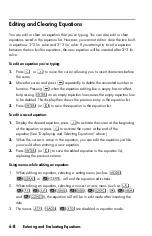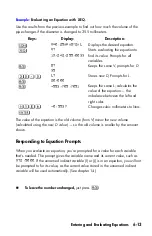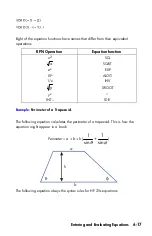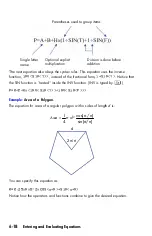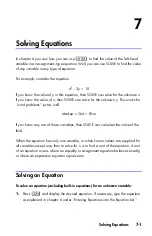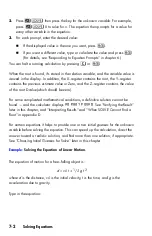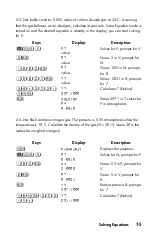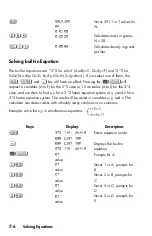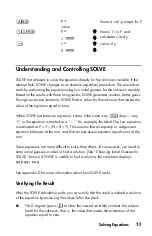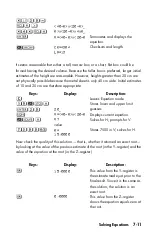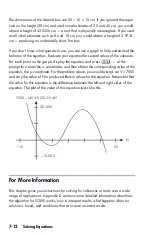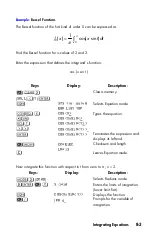
7-2
2.
Press
then press the key for the unknown variable. For example,
press
X to solve for
x.
The equation then prompts for a value for
every other variable in the equation.
3.
For each prompt, enter the desired value:
If the displayed value is the one you want, press
.
If you want a different value, type or calculate the value and press
.
(For details, see "Responding to Equation Prompts" in chapter 6.)
You can halt a running calculation by pressing
or
.
When the root is found, it's stored in the relation variable, and the variable value is
viewed in the display. In addition, the X–register contains the root, the Y–register
contains the previous estimate value or Zero, and the Z–register contains the value
of the root D-value(which should be zero).
For some complicated mathematical conditions, a definitive solution cannot be
found — and the calculator displays
. See "Verifying the Result"
later in this chapter, and "Interpreting Results" and "When SOLVE Cannot Find a
Root" in appendix D.
For certain equations it helps to provide one or
two initial guesses
for the unknown
variable before solving the equation. This can speed up the calculation, direct the
answer toward a realistic solution, and find more than one solution, if appropriate.
See "Choosing Initial Guesses for Solve" later in this chapter.
Example:
Solving the Equation of Linear Motion.
The equation of motion for a free–falling object is:
d
=
v
0
t
+
1
/
2
g t
2
where
d
is the distance,
v
0
is the initial velocity,
t
is the time, and
g
is the
acceleration due to gravity.
Type in the equation:
Summary of Contents for 35s
Page 1: ...HP 35s scientific calculator user s guide H Edition 1 HP part number F2215AA 90001 ...
Page 14: ...12 Contents ...
Page 15: ...Part 1 Basic Operation ...
Page 16: ......
Page 46: ...1 30 Getting Started ...
Page 63: ...RPN The Automatic Memory Stack 2 17 A Solution ...
Page 64: ...2 18 RPN The Automatic Memory Stack ...
Page 74: ...3 10 Storing Data into Variables ...
Page 180: ...12 14 Statistical Operations ...
Page 181: ...Part 2 Programming ...
Page 182: ......
Page 246: ...15 12 Solving and Integrating Programs ...
Page 270: ...16 24 Statistics Programs ...
Page 284: ...17 14 Miscellaneous Programs and Equations ...
Page 285: ...Part 3 Appendixes and Reference ...
Page 286: ......
Page 308: ...B 8 User Memory and the Stack ...
Page 322: ...C 14 ALG Summary ...
Page 336: ...D 14 More about Solving ...
Page 346: ...E 10 More about Integration ...
Page 352: ...F 6 Messages ...
Page 370: ...G 18 Operation Index ...
Page 382: ...Index 12 ...

